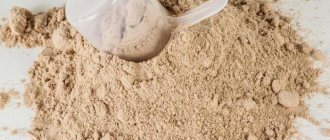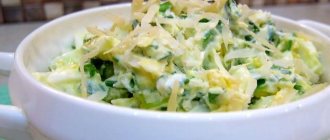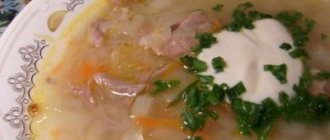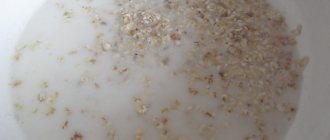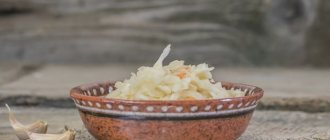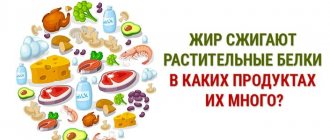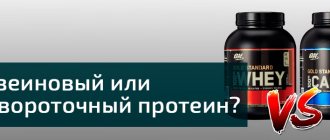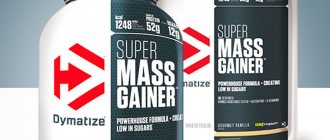Protein hydrolysates
Protein hydrolysates are protein breakdown products used for parenteral nutrition. They are well absorbed by the body, are a complete product of parenteral nutrition for various conditions accompanied by protein deficiency, and also reduce the effects of intoxication. Protein hydrolysates do not cause severe anaphylactoid reactions.
The following protein hydrolysates are used in medical practice: Hydrolysin (Hydrolysinum) - obtained from cattle blood proteins. Release forms: ampoules and hermetically sealed bottles of 250 and 500 ml. Store at a temperature of 4-6°. A drug similar to hydrolysine, obtained from homogeneous blood, is called aminokrovin.
Casein hydrolyzate (Hydrolysatum caseini) is a product of acid hydrolysis of casein. Release forms: ampoules of 250 ml, bottles of 200 and 400 ml. Store at a temperature of 10-23°.
Aminopeptide (Aminopeptidum) - prepared from cattle blood proteins. Release forms: ampoules of 250 ml and bottles of 250, 300 and 500 ml. Store at room temperature.
Protein hydrolysates are used for diseases accompanied by protein deficiency, and when increased protein nutrition is necessary (when the body is depleted, including gastrointestinal diseases, intoxication, burn disease, radiation sickness), as well as when it is impossible to eat by mouth (after surgery on esophagus, stomach). Protein hydrolysates are administered only by drip - intravenously and subcutaneously - in doses of up to 2 liters per day. Begin to administer slowly (20 drops per 1 minute). If there is no reaction (sometimes there is redness of the face, a feeling of heat, difficulty breathing), the rate of administration is increased to 40-60 drops per 1 ml. During the entire period of administration, it is necessary to monitor the patient.
Protein hydrolysates are contraindicated in cases of cardiac decompensation, cerebral hemorrhages, thrombophlebitis, acute nephrosis and nephrosclerosis.
Sometimes, when using protein hydrolysates, adverse reactions may occur: nausea, vomiting, fever, itchy skin, urticaria. In these cases, the use of diphenhydramine (1 ml of 1% solution intramuscularly or intravenously), calcium chloride (intravenous 5-10 ml of 10% solution) is indicated. See also Blood replacement fluids.
Protein hydrolysates are products of the hydrolytic breakdown of proteins used for parenteral administration to the body for medicinal purposes. In the process of obtaining protein hydrolysates, the protein is split into short di- and tripeptide chains and individual amino acids, losing its specific properties, primary toxicity and anaphylactogenicity. Protein hydrolysates are obtained mainly from animal blood or milk protein (casein) using acid, alkaline or enzymatic hydrolysis. The most widespread in the Soviet Union are three protein hydrolysates produced under industrial conditions—hydrolysine (L-103), casein hydrolysate and aminopeptide.
Hydrolysine (L-103) is obtained from bovine serum, whole blood or blood clots. Hydrolysis is carried out with hydrochloric acid at boiling point; An ion exchange resin is used to remove acid; the finished product is sterile filtered and bottled. Contains: 0.7-0.9 g% nitrogen and a set of salts present in blood plasma.
Casein hydrolyzate (COLIPC) is obtained by boiling casein with sulfuric acid; removal of sulfate ions is achieved by using an ion exchange resin; the finished hydrolyzate is sterilely filtered and bottled and can withstand hot sterilization. Contains: nitrogen 0.70-0.95 g%, amine nitrogen 35-45 g%, as well as chloride salts of sodium, potassium, calcium and magnesium in quantities equal to their concentration in the blood plasma.
Aminopeptide is prepared from cattle blood by hydrolysis with a pancreatic enzyme. In terms of the content of total and amine nitrogen and salts, it is similar to the described protein hydrolyzate.
aminokrovin is prepared from blood clots remaining after collecting donor serum ; hydrolysis is carried out using hydrochloric acid. Protein hydrolysates are produced abroad mainly from casein: in the USA - Amigen , in Sweden - aminosol , in England - cazidrol , etc.
Protein hydrolysates are effective preparations for parenteral protein nutrition; they are well absorbed by the body when administered intravenously and subcutaneously, restoring the disturbed nitrogen balance, which leads to an increase in the protein content in the blood plasma. The use of protein hydrolysates is indicated in all cases where normal oral nutrition is impossible, in diseases accompanied by the development of protein deficiency and the resulting weight loss, in slow healing of wounds, reduced resistance to infections, impaired liver and kidney function, in preparation for operations and in the postoperative period, with burns, intoxications, peptic ulcers. To combat shock, protein hydrolysates are used - blood substitutes such as dextran (polyglucin), and for detoxification - polyvinylpyrrolidone preparations (hemodez).
Protein hydrolysates are administered by drop method - intravenously, subcutaneously - in doses of up to 2 liters per day. Protein hydrolysates are produced without glucose and with glucose, which increases their effectiveness; the addition of vitamin B12 also promotes better absorption of protein hydrolysates; the effectiveness of protein hydrolysates can be increased by adding alcohol, fat emulsion, etc. Rate of administration: 20-70 drops per minute; when the speed increases, nausea, urticaria, and headache may appear; in these cases, the transfusion is stopped for a few minutes and then resumed, but at a slower rate.
Contraindications: cardiac decompensation, cerebral hemorrhage, thrombophlebitis, acute nephrosis and nephrosclerosis.
The release form of protein hydrolysates is 450-500 ml bottles; Shelf life: 5 years.
See also Blood replacement fluids.
Processing methods
Although protein powders are made directly from food, they are not whole foods.
They are created by extracting the protein component through various processing methods.
Different protein sources require different processing methods. For example, as is easy to understand, obtaining protein from starchy rice is associated with some difficulties.
Here are typical processing methods.
Protein concentrates
Concentration is a high temperature drying and acid extraction process to reduce the food source into a concentrated protein powder.
Other impurities (eg lactose, fat, cholesterol) may be concentrated during processing.
Concentrates contain approximately 60-70% protein by weight.
Protein isolates
The idea of an isolate is to extract most of the protein from the original product. This is achieved by alcohol cleaning, water cleaning or ionization.
Each method has a different cost. Water is the cheapest, and the ionization process is the most expensive.
After obtaining the isolate, it is further subjected to a filtration process. This removes almost everything except the protein. A minimum of carbohydrates, fats, fibers and phytochemicals remain.
Protein isolate contains approximately 90-95% protein by weight.
Protein hydrolysates (hydrolyzed mixtures)
Hydrolyzed protein is created by adding water to protein polymers, which are then broken down into miniature groups of protein called peptides. The groups range in size from 2 to 5 amino acids.
Molecular size enhances absorption. Hydrolysis is essentially a preliminary splitting.
Hydrolyzed protein is very expensive to produce.
Ion exchange protein
Ions are atoms or molecules containing charge-forming groups.
During ion exchange, protein molecules are separated from other fractions using an electrical charge. This is the industry standard for milk protein processing.
Microfiltration, cross-microfiltration, ultrafiltration
These are powerful filtration processes that remove contaminants from a concentrated protein component by passing through a membrane. They are similar to reverse osmosis processes used to purify water.
Description
Protein hydrolysates are substances obtained as a result of the decomposition of protein by reaction with water. Decomposition occurs in the presence of catalysts: acids, alkalis or enzymes. As a result, the peptide bonds of the high-molecular chain are destroyed, and the final product is a complex mixture consisting of individual amino acids, their sodium salts and polypeptide residues. This process is shown in the picture below using a tripeptide as an example.
You may be interested in:Unique properties of the mineral limonite
Hydrolysates of different types of proteins, obtained at the same depth of their cleavage, have an identical composition. These substances are valuable biologically active compounds, since amino acids are the main source of nutrition for tissues and their “building material”, and peptides participate in the synthesis of amino acids, play an intermediary role in metabolic processes and serve as immunomodulators.
You might be interested in:Which quadrilateral is called a square and which is a rectangle. Which quadrilateral is called a trapezoid
Channel PROGRAMMER'S DIARY
The life of a programmer and interesting reviews of everything. Subscribe so you don't miss new videos.
The main components of protein hydrolysates are shown in the illustration below.
The final product contains the following amino acids in greatest quantities:
- glutamine;
- aspartic;
- pyrrolidine-α-carboxylic (proline);
- 2-amino-5-guanidinepentane (arginine);
- 2-aminopropane (alanine);
- 2-amino-4-methylpentane (leucine).
Infant formulas: protein hydrolysates in baby food
Cow's milk, which is the main raw material for infant formula for artificial breastfeeding, can cause allergic reactions. High molecular weight whey proteins have the greatest activity in this regard: alpha-lactoalbumin, beta-lactoglobulin and casein.
The most effective way to reduce the allergenicity of milk at present is to obtain milk protein hydrolysates using enzymes and their subsequent ultrafiltration. Such mixtures contain low molecular weight peptides with a molecular weight of less than 1500 D, and their tolerability among children with allergies is at least 90%.
Based on the type of protein used to make the dairy product, mixtures are divided into casein, whey (the most common), soy, and mixed. They are also prescribed for malabsorption of nutrients in the intestines and for the prevention of food allergies.
Source
Why use protein powder?
Regardless of your personal goals, it is important to get enough protein. Protein can help you manage your weight and body composition, while also enhancing muscle growth, improving immunity, and repairing cells.
Protein powders can be helpful if you don't get enough protein from whole foods, or if you want the convenience of a protein source that doesn't spoil for a long time.
After all, it's a lot easier to throw a bag of protein powder into your gym bag than a chicken breast, and it makes a better smoothie than, say, a steak.
With numerous studies demonstrating the importance of protein for both body composition and health, protein supplements are among the most popular protein products.
You must know
Most protein powders have strengths and weaknesses.
Rice protein is hypoallergenic, gluten-free, taste-neutral, and economical. 100% plant based. Can be obtained from genetically modified rice.
Egg whites are fat-free and contain concentrated amounts of essential amino acids. May lead to digestive disorders.
Dairy protein (including whey, casein, calcium caseinate and milk protein blends) can boost immunity due to its high BCAA content and contains the well-studied lactose. May cause digestive upset or other symptoms in people sensitive to whey, casein and/or lactose.
Legume protein – contains no saturated fat or cholesterol, highly digestible, hypoallergenic, economical. Rich in lysine, arginine and glutamine. 100% plant based.
Hemp Protein – Provides omega-3 fatty acids, provides fiber, does not contain trypsin inhibitors, and is high in arginine and histidine. 100% plant based.
Soy protein – beneficial for the prevention of cardiovascular disease, contains some anti-nutrients, and can be obtained from genetically modified soybeans. 100% plant based.
Cranberry protein – may retain antioxidants after processing. Obtained from cranberry seeds. Contains omega-3 fatty acids. 100% plant protein.
Artichoke protein is a source of inulin (prebiotic). Rich in BCAA. 100% plant based.
Classification of Protein Supplements: Sources of Raw Materials
Protein supplements are based on milk (milk concentrate, isolate and hydrolyzate, casein - calcium and sodium caseinates, micellar casein) and plant-based - soy, pea, hemp, rice, wheat; hydrolyzed beef protein, hydrolyzed collagen and egg white.
Which one is better? Everyone decides for themselves. If the speed of absorption is important to you, then any hydrolysates will be your priority, because the protein is already broken down into peptides of greater or lesser length. Based on nutritional value, whey protein contains the maximum amount of BCAA amino acids, which means it is excellent for muscle growth.
Beef protein is also a good anabolic substrate, because a serving of such protein essentially contains the protein of a hundred-gram steak. Casein, with its long molecules and high glutamine content, is an excellent anti-catabolic and immune stimulant, and is good to take at night or between meals to maintain amino acid levels in the blood.
Now let's take a closer look at each type of protein.
Whey Protein
It is obtained from milk. This is the liquid that separates from curdled milk during the cheese making process. It's high in protein, but it also contains lactose and milk sugar, which many people have difficulty digesting.
While whey protein concentrate retains some lactose, isolate contains little because most of this milk sugar is lost during processing.
Whey is quickly absorbed and rich in branched chain amino acids (BCAAs). Leucine, an amino acid, plays an important role in stimulating muscle growth and recovery after endurance exercise.1
Research shows that whey protein can help build and maintain muscle mass, recover from hard workouts, and increase strength.2
One Canadian study of young men found that taking whey protein after resistance exercise increased muscle protein synthesis by 31% compared to soy protein and 132% compared to casein. .3
Other studies in normal-weight, overweight, and obese people show that whey protein can improve body composition—reducing fat mass and increasing muscle mass.4
Casein
Casein, like whey, is found in milk, but is digested and absorbed much more slowly.
When casein reacts with stomach acid, it forms a gel, slowing gastric emptying and delaying the absorption of amino acids into the blood.
This results in a gradual, more sustained effect of amino acids on the muscles, which reduces the rate of muscle protein breakdown.5
Therefore, choose this type of protein if you need to extend the digestion time of the protein.
Egg protein
Eggs are an excellent source of high-quality protein. Egg protein is second only to whey in leucine, which is most important for muscle health.6
Of all whole foods, eggs have the highest protein digestibility amino acid score (PDCAAS).7
Eggs also reduce your appetite and help you stay full longer.
Protein quality
Proteins can be classified by quality. Protein quality is determined by the following criteria.
The protein efficiency ratio is the weight gain of the test subject (rat) divided by the consumption of a specific dietary protein during the control period. This method determines the amount of protein needed for growth rather than for use.
Net protein utilization is the ratio of the amino acids from which the protein was synthesized to the amino acids supplied. It can be described differently as the amount of protein that comes with food, taking into account its digestibility and amino acid composition. This test is influenced by essential amino acids in the body and limiting amino acids in food.
Biological value is the proportion of protein absorbed from food that is converted into body proteins. In this case, the circulation of nitrogen is taken into account. Calculation of biological value does not take into account how protein is digested and absorbed. The reading may be inaccurate due to recent food intake.
The Protein Digestibility-Adjusted Amino Acid Score is a measure based on the amino acid requirements of young children. It takes into account protein digestibility. This is a recently developed indicator and is preferred for determining protein quality.
Receipt
There are 3 main methods for producing these compounds:
The following substances are used as enzymes:
Complete protein hydrolyzate contains a complete set of amino acids in an optimal ratio, which is especially important for dietary, medical and veterinary purposes. Such a composition can be obtained by deep processing of raw materials, by boiling the solution for many hours in the presence of acid catalysts.
